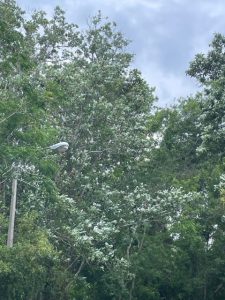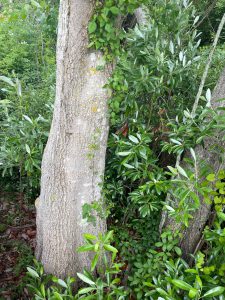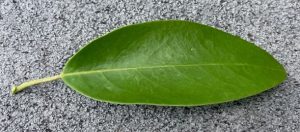
Sweet bay trees (Magnolia virginiana) are the sleeker, swampier cousins of the stately Southern magnolia (Magnolia grandiflora). I have a soft spot for magnolias in general, but especially for the sweet bay. It was the first species I learned to quickly identify in the field during my early career as a wetland ecologist. Once you know how to spot them, you’ll see them all over—they are recognizable by their silvery leaves flapping in the wind. Known by the botanical term glaucous, this light-gray/blue color is created by tiny hairs on the back of each leaf.

Sweet bays are native to freshwater swamps. They thrive on the edges of creeks, in shady forested areas, and along roadsides in low-lying areas. In cooler climates north of here, the trees grow 10-20 feet tall, but in the fertile swamps of the Gulf Coast you can see them towering 80-100’ in the air. Their bark tends to be a whitish gray. Like many swamp-dwelling trees, the bases of sweet bays are often identifiable by their wide, buttressed trunks. This widening of the trunks is an adaptation to living in wet soil that may include standing water. A broader base supports and stabilizes the tree in mucky soil, akin to an athlete crouching in a wide stance to maintain footing from an oncoming tackle or punch.

The sweet bay magnolia blossom is a delicate miniature of the Southern magnolia, with a fragrant white flower present in late spring. And while Southern magnolias have thick, almost leathery leaves, sweet bay magnolia leaves are thin and lightweight.


Their leaves are aromatic, as well, giving off a distinctive scent when crushed. There are several “bay” species that work as culinary additions to soups and gumbo, but sweet bay leaves are the traditional choice along the Gulf Coast. While you can purchase Mediterranean laurel bay leaves in the spice aisle at your local grocery store, I prefer to use local sweet bay leaves, as the flavor is more robust when they are fresh.

There are several excellent and accessible stands of sweet bays visible at the new wetland boardwalk at Gulf Breeze’s Shoreline Park, identified by full-color signage. You can also see these trees regularly along Interstate 10, their silvery leaves fluttering in the wind as you pass at 70 mph!
 6
6
